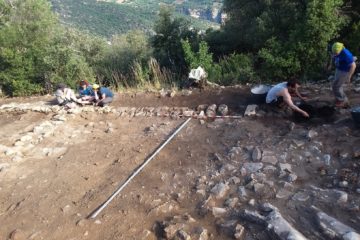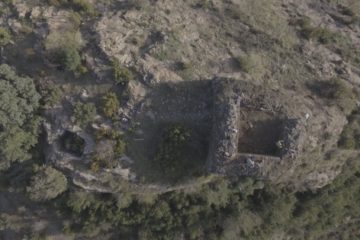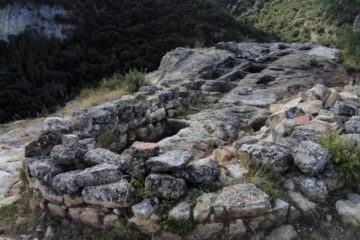Site: Els Altimiris (St. Esteve de la Sarga, Pallars Jussà).
Campaigns: 2004 to present.
Directors: Marta Sancho (2004-2021), Walter Alegría (2007-2021), Núria Artigas (2017) and Jordi Valverdú (2019, 2021).
Description:
Els Altimiris, located at the highest point (c. 900 m) of one of the counter-scarps of Montsec d’Ares (Pre-Pyrenees of Lleida), in a context of forests and pastures and at an intermediate point of the primitive bishoprics of Ilerda, Urgellum and Huesca, is presented as an example of the first monastic establishments that were founded between Antiquity and the High Middle Ages.
The written sources of Late Antiquity refer relatively frequently to these mountain monasteries, but there is still a great deficit in terms of their archaeological identification, partly due to two circumstances: often the intrinsic structural configuration of these sites does not differ -apparently- from that of a settlement or village of civilian character; and several of these primitive monasteries are still active during the Middle Ages and modern centuries, which means that the foundational levels and structures are razed, making it difficult to identify them as a monastic space.
The site is located on a more or less triangular surface, with a steep slope, bounded by two cliffs (E and W) and a large enclosure wall (N). The lines of the precipices intersect at a vertex where the ‘Pas de Santa Cecília’ is located, a narrow pass consisting of a large rocky mass modified by the human hand that in turn would serve as a cattle counter, and hagiotoponym that must be related to the dedication of the church of the site, of which there is no known documentary reference. With a chronological arc that goes from the V to the VIII/beginning of the IX century and a peak in the VI-VII centuries, the archaeological data reveal the existence in a central point of the site of a complex set of buildings made of blocks joined with lime mortar and sand, with interior and exterior plaster, distributed around a church with a single nave and semicircular apse inscribed in a rectangle; this church was founded towards the end of the V century. Around it are distributed other structures: a rectangular building of communal character built with techniques of late Roman tradition (opus caementicium and opus signinum), and several small hut bottoms semi-excavated in the rock.
Among the fragmented archaeological material, a small mortar and the iron structure and bronze plate of a precision balance stand out; analyses of the bottom of the plate have revealed the elaboration of pharmacopoeia products and derivatives of arboreal resins. Among the ceramic forms, there is an abundance of everyday vessels such as jars and pots, and to a lesser extent luxury ware (DSP, TSHT, ARS). Amphorae for wine and oil also stand out. The metals are represented by numerous construction nails related to the roofs, a small shearing, and several needles belonging to belt buckles. The furniture catalog is completed by several remains of iron and glass slag, as well as lithic materials (sharpeners, stones and flint flakes).
The study of the faunal remains shows a predominance of ovicaprines, followed in smaller percentage by leporids, suids and bovids; and in a very residual way cervids, equids and canids. But the finding that has attracted the most attention is a set of oysters located in one of the rooms around the basilica, given that the Montsec area is quite far from the coast (about 180 km).








